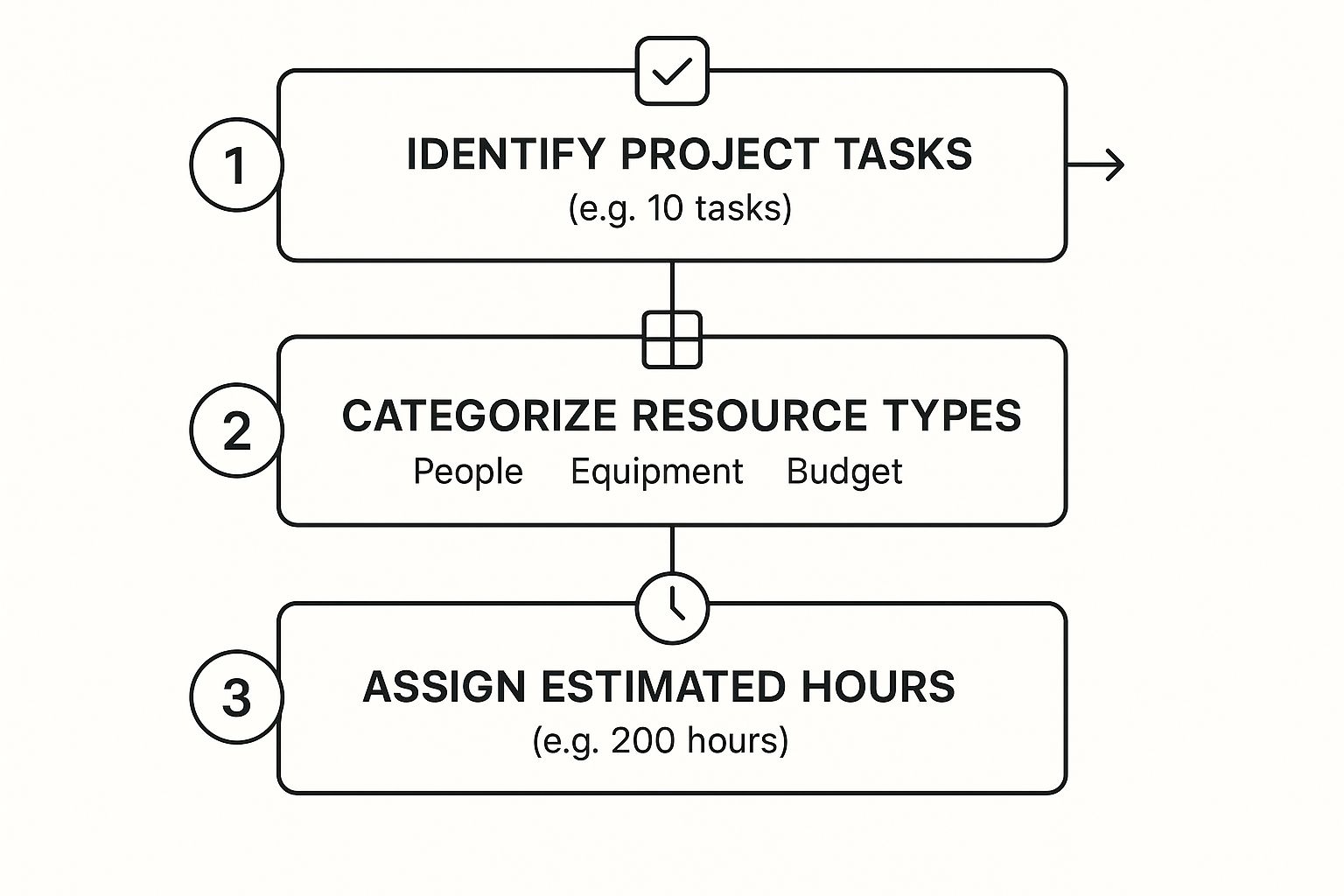A project management resource plan is essentially a detailed roadmap outlining every resource you'll need to get a project across the finish line. We're talking about people, equipment, materials—the whole lot. It’s the blueprint that makes sure you have the right resources, in the right place, at the right time. Get this right, and you’ll sidestep those all-too-common budget blowouts and team burnout.
Why Resource Planning Is Your Project's Lifeline
So many projects fail not because the idea was bad, but because of a simple lack of foresight. Just picture it: a talented team, completely derailed by burnout, creeping costs, and a string of missed deadlines. These are all classic symptoms of shoddy resource allocation. This is precisely where a solid resource plan stops being just another document and becomes the central nervous system for your entire project.
Having a plan gives you the strategic vision to head off common disasters before they even start. It’s a direct boost to your bottom line, team morale, and the chances of a successful delivery. Without one, you’re basically flying blind, just hoping you have enough fuel in the tank to reach your destination.
Moving Beyond Guesswork to Strategic Allocation
Good planning flips the script on resource management. Instead of constantly putting out fires, you’re thinking ahead and making strategic moves. It forces you to get critical about not just who you need, but what specific skills are required for each and every phase of the project.
Think about a typical software development project. You might need a senior backend developer hammering away for the first two months, but you’ll only need a part-time QA tester for the final month of testing. A proper plan accounts for this nuance, preventing you from booking—and paying for—a full-time tester for the entire project. This granular approach isn't just about filling seats; it’s about strategically placing your experts where they can make the biggest impact.
A huge benefit here is achieving peak efficiency by mastering resource allocation optimization. This is how you turn your team's unique skills and availability into a real competitive advantage.
The Tangible Benefits of a Solid Plan
Investing the time upfront to build a detailed plan pays off in a big way. It creates a single source of truth that clarifies expectations for everyone involved, from the highest-level stakeholders right down to individual team members.
Your best defense against scope creep and budget overruns is a well-structured plan. It gives you a clear baseline, making it much easier to spot when new requests fall outside the original agreement and to justify the need for more resources.
This proactive approach delivers several clear wins:
- Improved Budget Accuracy: When you identify all your resource needs from the get-go, you can build a much more realistic budget and drastically reduce those nasty, unexpected expenses.
- Enhanced Team Morale: Teams are far less likely to burn out when their workloads are balanced and predictable. A clear plan shows you respect their time and expertise.
- Increased Stakeholder Confidence: Walking into a meeting with a detailed resource plan shows you’ve done your homework. It demonstrates professionalism and builds trust right from day one.
Ultimately, creating a project management resource plan is an exercise in managing risk. You’re actively looking for potential bottlenecks, scheduling conflicts, and skills gaps before they can blow up into full-blown crises. By anticipating these hurdles, you can build contingency plans and keep your project on track, even when the unexpected happens. To see how this works in different settings, it's worth exploring modern resource planning use cases at https://www.timetackle.com/use-cases/resource-planning/ to find an approach that fits your team.
Laying the Groundwork for a Solid Resource Plan
Before a single task gets assigned or a dollar is spent, the real work of resource planning begins. This is where you separate a plan that actually works from one that’s pure wishful thinking. Think of it as building a detailed blueprint, not just jotting down a list of names.
This whole process kicks off with a deep dive into your project’s core documents—the project scope and the Work Breakdown Structure (WBS). These aren't just formalities; they’re the treasure maps that reveal every single task, deliverable, and milestone. By methodically pulling apart the WBS, you can make sure no piece of work gets overlooked, no matter how small.
Deconstructing the Work to Define Needs
Your first real objective is to translate all those project activities into concrete resource requirements. This means you need to look past generic job titles and get really specific about the skills and tools you'll need on the ground.
Don’t just write down "developer." Instead, define the need for a "Senior Full-Stack Developer with Python expertise" or a "Junior UI Designer proficient in Figma." This level of detail is absolutely critical for accuracy.
For every task you pull from your WBS, ask yourself these questions:
- What specific skills are essential to get this done? (e.g., copywriting, database administration, video editing)
- What level of experience do we really need? (e.g., junior, mid-level, senior, or a true subject matter expert)
- What tools or equipment are non-negotiable? (e.g., certain software licenses, testing hardware, a video production studio)
Answering these forces you to think through the practical realities of getting the work done, which helps prevent those last-minute scrambles for qualified people or essential equipment. A marketing campaign plan, for example, might break down into tasks needing a graphic designer, a social media manager, and a data analyst—each with their own distinct skills and software needs.
Collaborating for Realistic Commitments
Once you have a crystal-clear picture of what you need, the next move is to find out what's actually available. This is where collaboration becomes your most valuable tool. A plan created in a vacuum is destined to fail. You have to get in a room (virtual or otherwise) with department heads and team leaders—the people who have a real pulse on their team's capacity and current projects.
Schedule dedicated meetings to walk them through your resource list. Lay out your needs clearly and be ready to negotiate. You might hear that their top designer is already booked solid on another high-priority project for the next month. This isn't a roadblock; it's an early warning sign and an opportunity to find a solution now. Can a mid-level designer handle the initial phases? Can the timeline be tweaked?
Securing these commitments is about more than just getting a verbal "yes." It's about building a shared understanding of priorities and ensuring your project gets the attention it needs to succeed.
This process also has the huge benefit of uncovering potential bottlenecks long before they blow up your timeline. If you find out the entire QA team is at capacity for the next quarter, you know right away that you need to either adjust your testing schedule or start exploring external resources.
Documenting Assumptions: A Critical Risk Mitigation Step
Every plan you'll ever make is built on a foundation of assumptions. You assume key people won't take an unexpected extended vacation, that a critical piece of software will be ready to go, or that team members actually have the skills listed on their profiles. Flying blind on these assumptions is a massive risk.
Documenting them isn't optional; it's a non-negotiable part of your groundwork. Create a simple log of every assumption you've made during the planning phase.
Example Assumption Log:
| Assumption | Potential Impact if Incorrect | Mitigation Plan |
|---|---|---|
| Sarah (Lead Dev) will be available 100% in Q3. | Project timeline delayed by 4-6 weeks. | Confirm Q3 availability with Sarah and her manager; identify a backup developer for non-critical tasks. |
| The new analytics software will be approved and installed by June 1st. | Reporting deliverables will be delayed; manual data analysis will be required. | Follow up weekly with IT on procurement status; develop a temporary manual reporting template as a backup. |
This proactive approach transforms those vague worries into actionable risk management. It forces you to game out what could go wrong and to build contingency plans from day one, making your project management resource plan far more resilient.
It also sharpens your ability to manage team capacity, which is a major hurdle for many organizations. In fact, capacity planning issues are a key reason why only about 23% of employees feel engaged at work, as constant overwork leads to burnout. You can explore more insights on how strategic capacity planning impacts project success on runn.io.
Building Your Resource Plan from Scratch
Okay, let's get down to business. Moving from theory to the real world is where a project management resource plan stops being a concept and starts being a tool. This is where you roll up your sleeves and build a clear, functional document that will actually guide your project—turning all that foundational work into a tangible schedule of who does what, and when.
The first major hurdle? Forecasting your resource needs with any degree of accuracy. Look, nobody expects you to have a crystal ball. But you can get remarkably close by using proven estimation techniques instead of just winging it.
Forecasting Your Resource Needs
Solid forecasting isn't about guesswork; it's about using logical frameworks to make an educated prediction. Two of the most practical methods I've leaned on over the years are analogous and parametric estimating. They serve different purposes, but using them together is a game-changer.
Analogous estimating is your classic top-down approach. You look at similar projects you've already knocked out of the park and use their actual resource data as a baseline. For instance, if a previous software update took two developers 400 hours, it's reasonable to pencil in a similar number for a new, comparable update. It's quick, but its accuracy really depends on how similar the old project is to the new one.
Parametric estimating gets more granular. It's a data-driven method that uses the statistical relationship between historical data and other variables. A perfect example: if you know your team can typically develop and test one feature in about 50 hours, you can scale that up. For a project with ten features, you're looking at an estimate of 500 hours for development and QA. This way is almost always more accurate.
The real magic happens when you blend these techniques. I always start with an analogous estimate to get a ballpark figure early on. Then, as we break the work down into smaller, more measurable tasks, I'll refine it with a parametric approach.
This two-step process takes forecasting from a shot in the dark to a calculated prediction. This flow—from identifying the work to estimating the hours—is the very foundation of a solid plan.
Here's a simple way to visualize how you get from a list of project tasks to a time-based resource estimate.
This flow really nails the core logic: turning project requirements into a quantifiable estimate of the effort needed from your team and equipment.
Allocating and Scheduling Resources Visually
Once your estimates are in hand, the next move is to map everything out on a visual resource schedule or calendar. Think of this as the single source of truth that connects every resource—people, equipment, facilities—to specific tasks on the project timeline. A simple spreadsheet might cut it for small projects, but for anything with moving parts, dedicated software is your best friend.
Let's use a tangible example, like a software launch. Your key resources are developers, QA testers, and marketers, all playing different roles at different times.
- Phase 1: Development Sprint (Weeks 1-4): You’ll need your two senior developers allocated for 100% of their time. Meanwhile, the marketing team is just dipping their toes in, maybe at 10% allocation for initial planning meetings.
- Phase 2: QA & Bug Fixing (Weeks 5-7): The developers' allocation can drop to 50% as they shift focus to fixing issues. Now, the two QA testers are at 100% capacity, and marketing ramps up to 40% to get launch materials ready.
- Phase 3: Launch & Promotion (Weeks 8-9): Developer and QA involvement drops to 20% for on-call support, while the marketing team goes all-in at 100% to execute the campaign.
Plotting this out visually is where you spot the problems before they happen. What if one of your senior devs has a vacation booked right in the middle of the bug-fixing phase? Your visual plan will flag that gap immediately, giving you time to find a backup or shuffle the timeline. No last-minute panic.
Clarifying Roles with a Responsibility Matrix
Defining roles clearly is just as critical as scheduling time. A simple RACI chart is a fantastic tool for this. It maps out who is Responsible, Accountable, Consulted, and Informed for each key activity, eliminating confusion from day one.
Here’s a simplified look at what this might look like for our software launch.
Resource Role vs. Responsibility Matrix (RACI Chart)
| Activity / Deliverable | Project Manager | Lead Developer | UX Designer | Client Stakeholder |
|---|---|---|---|---|
| Project Kickoff | A | R | C | I |
| Wireframe Design | A | C | R | C |
| Sprint Planning | A | R | C | I |
| Code Development | I | R | C | I |
| User Acceptance Testing | A | C | C | R |
| Launch Approval | A | I | I | C |
This simple matrix makes it crystal clear who owns what. No more "I thought they were handling that" conversations.
Creating this visual map is also fundamental for managing team workloads. It's not just about tracking tasks; it's about seeing the actual time commitment needed from each person. For a deeper dive into this, you can learn more about how project management and time tracking work together to create a balanced workflow. That synergy is what prevents team burnout and keeps a project sustainable.
Ultimately, your goal is a living document that keeps everyone aligned and accountable. It’s not meant to be set in stone. It's a dynamic tool that helps you navigate the project, make smart decisions, and adapt to the inevitable curveballs. That's what makes a project management resource plan so indispensable.
Using Technology For Smarter Resource Planning
Trying to manage your resource plan with a spreadsheet is like navigating with a paper map in the age of GPS. Sure, it can get you there, but it’s slow, full of potential errors, and becomes obsolete the second you hit "print." Modern project management tools have completely changed the game, turning what was a static document into a dynamic, living system.
When you ditch the manual tracking, you gain a single, real-time view of your entire talent pool. This is the difference between guessing who’s available and knowing with complete certainty. You can sidestep overallocation issues and find the perfect expert for a new task in seconds.
Essential Features in Modern Resource Planning Tools
Not all software is built the same, though. As you start looking at different platforms, you'll find some features are absolutely non-negotiable for anyone serious about resource management. These are the capabilities that truly separate a glorified to-do list from a powerful planning platform.
You should be looking for tools that offer:
- Real-Time Utilization Tracking: This gives you an instant snapshot of who is overbooked, who has bandwidth, and how the hours being worked are stacking up against what you originally planned.
- Skills-Based Filtering: Forget just searching by job title. You need the ability to find a "certified cloud architect" or a "bilingual copywriter" by drilling down into specific skills, certifications, or experience levels.
- Automated Conflict Alerts: The software should immediately flag you if you try to assign a task to someone who's already swamped or booked on another project. This prevents conflicts before they can even start.
- Scenario Planning: This is a big one. You need the ability to build "what-if" scenarios to see how a new project or a shifted deadline would impact your team's commitments—all without messing up your live plan.
These features transform your plan into a command center for your resources, letting you make smarter, data-driven decisions on the fly. Some platforms even take this a step further with advanced integrations, like with Smartsheet time tracking, which pulls actual effort back into the resource plan for an unmatched level of accuracy.
The Power of an Integrated Software Ecosystem
The real magic happens when your resource planning software isn't operating in a silo. When you connect it to your other critical business systems—like your CRM, HR platform, and financial tools—you create a seamless flow of information from the initial project bid all the way to the final invoice.
Imagine this: a sales rep closes a deal in your CRM, and that action automatically triggers a resource request, flagging the need for an implementation specialist. This kind of proactive approach cuts out the manual handoffs and guarantees projects are staffed correctly from day one. To get your timelines right from the start, you can use specialized production time and labor estimation tools to build more accurate forecasts for complex development or manufacturing work.
By integrating your tools, you create a single source of truth for all project data. This eliminates discrepancies between what sales has promised, what project management has planned, and what finance has budgeted.
This shift toward integrated, intelligent tools is why we're seeing such a massive expansion in the project management software market.
The market's projected surge to over $12 billion by 2030 shows a clear industry-wide trend. With 82% of companies already using these platforms, adopting the right technology is no longer just a way to get ahead—it's a basic requirement for staying efficient. This data confirms that organizations are actively investing in digital solutions to better manage their most valuable asset: their people.
Adapting Your Plan When Reality Hits
Let's be honest: a project management resource plan isn't some static document you frame and hang on the wall. Think of it more as a living guide, one that's designed to evolve. The real world of project management is messy and unpredictable, and a plan that can’t bend will inevitably break.
True success isn’t about creating the perfect plan from day one. It’s about your ability to monitor how resources are actually being used, spot when things start to go off-track, and make intelligent, agile adjustments along the way.
Things rarely go exactly as planned. You're going to face curveballs. A key team member might have an unexpected absence, project priorities can shift overnight, or an urgent stakeholder request throws a wrench in your perfectly crafted schedule. The key is to treat these events not as failures of the plan, but as tests of its flexibility.
Proactive Monitoring and Early Detection
The secret to adapting well is seeing trouble coming before it arrives. This takes more than just a casual weekly check-in; it means having a real-time pulse on your resource utilization. Are your developers logging way more hours than you anticipated? Is the design team consistently underutilized?
These are the early warning signs that your initial estimates might have been off or that scope creep is quietly setting in. Regularly tracking actual hours against your planned hours is the simplest, most effective way to catch these variances.
Don't wait for the end-of-month report to discover a problem. By then, a small deviation can snowball into a major budget overrun. Proactive monitoring transforms you from a reactive firefighter into a strategic pilot, capable of making small course corrections to stay on track.
This constant vigilance lets you handle issues while they're still small and manageable, instead of waiting for them to become full-blown crises that threaten your timeline and budget.
Handling Common Resource Scenarios
Sooner or later, you'll find yourself in one of these situations. It's not a matter of if, but when. Here’s how to handle them without derailing the entire project.
- A Key Resource Suddenly Becomes Unavailable: Your lead engineer calls in sick for a week right in the middle of a critical sprint. Don't panic. Pull up your resource plan. Who has a similar skill set? Maybe a mid-level developer can step in to handle the less complex tasks, freeing up another senior resource to cover the absolutely critical work.
- An Urgent, High-Priority Task Appears: A major client has an emergency request that needs immediate attention. This is all about making a trade-off. You have to quickly assess the impact on your current projects. Can a lower-priority task be pushed back? Do you have anyone on the team with a little bandwidth who can absorb this new work?
- A Task Is Taking Longer Than Expected: Your initial estimate was a bit too optimistic, and now a deliverable is falling behind schedule. This is where open communication is everything. Talk to the team to get to the root cause. Do they need more support, or was the task just way more complex than anyone realized? Adjust the plan by either reallocating some help or, just as importantly, communicating a revised timeline to stakeholders right away.
Modern resource management now leans heavily on data to make these decisions easier. Instead of just guessing, project managers can use historical project data and predictive tools to forecast needs more accurately and avoid overallocation from the start. These systems can spot potential resource conflicts before they happen and even suggest alternative team members based on their skills and current workload. You can discover more insights about how data is shaping resource planning at retaininternational.com.
Communicating Changes Effectively
Adapting your project management resource plan is only half the battle. The other half is communicating those changes clearly and confidently.
When you have to make adjustments, transparency is your best friend for managing stakeholder expectations.
Explain why the change is necessary, what the impact will be, and lay out your new plan to move forward. A simple, proactive update can head off a lot of frustration and maintain trust, ensuring everyone stays aligned even when the path forward has a few unexpected turns.
Answering Your Toughest Resource Planning Questions
Okay, so you’ve built your resource plan. On paper, it looks perfect. But we all know that the real world of project management is a lot messier. What happens when your star engineer is suddenly needed on three different "high-priority" projects? Or when you're trying to forecast for an agile team that doesn't work in neat, predictable task blocks?
These are the situations where theory meets reality. Let's dig into some of the most common—and frankly, most frustrating—questions that pop up once you start putting your resource plan into action.
How Do I Handle Resource Conflicts Across Multiple Projects?
This is the big one. It's probably the most frequent headache for any project manager in a growing company. You have one specialist, and suddenly, they're the most popular person in the building, with three project managers vying for their time. Just letting it play out is a surefire way to burn out your best people and blow your deadlines.
The first step is always centralized visibility. You simply can't solve a problem you can't see. Trying to manage this on scattered spreadsheets is a nightmare. A shared resource management tool is essential here; it creates a single, reliable view of who is working on what across every single project.
Once everyone is looking at the same data, you can start making smart moves:
- Create a Prioritization Framework: Let’s be honest, not all projects are created equal. You need to sit down with leadership and get a clear, objective ranking of which projects are most critical to the business. This stops the "whoever shouts loudest" method of resource allocation.
- Time-Slice the Work: Does that developer really need to be 100% dedicated to Project A this week? Maybe they can give 20 hours to Project A and 20 to Project B. This forces you to get crystal clear on the most critical tasks for each project, but it’s often a very effective way to keep multiple streams of work moving forward.
- Stagger the Timelines: Take a hard look at the project dependencies. If two major initiatives need the same person at the same time, can one of them be pushed back a week or two? A small shift in a start date can often resolve a huge resource bottleneck without derailing the entire portfolio.
At the end of the day, solving these conflicts isn't about finding some magical, perfect answer. It's about having a strategic conversation backed by clear, undeniable data.
What Is the Best Way to Estimate for Agile Teams?
Resource planning for an agile team can feel a bit counterintuitive, especially if you come from a traditional waterfall background. But it's just as important—you just have to change how you think about it. You're moving away from planning granular, individual tasks and shifting towards planning for the team's capacity over time.
You aren't going to assign a specific developer to a specific bug fix six months from now. Instead, your resource plan is about securing a stable, cross-functional team for the project's duration. The plan's job is to protect that team's time and focus.
For agile teams, the project management resource plan isn't about mapping every single task. It's about protecting the team's capacity and focus, sprint after sprint. Your goal is to ensure the team as a whole is available, not to micromanage every individual hour.
Your estimates should be built around team velocity—the average amount of work the team can knock out in a typical sprint. From there, the resource plan is a simple calculation: how many sprints will it take to complete the backlog? This gives stakeholders a solid forecast of the resource investment while giving the team the flexibility it needs to adapt.
What Should I Do When I Don't Have All the Resources I Need?
It happens. In fact, if you've done your planning thoroughly, discovering a resource gap is pretty common. Don't see it as a failure of your plan; see it as the plan working. You've proactively identified a problem before it became a crisis.
The second you see a shortfall—whether you're missing a key skill or just don't have enough people—you’ve got a few levers to pull.
First, always re-evaluate the project scope. Is every single feature a non-negotiable "must-have" for launch? Often, the quickest and cheapest fix is to trim or phase lower-priority items.
If cutting scope isn't an option, it's time to explore other paths:
- Upskilling or Training: Is there someone on the team who could be trained to fill the gap? This is a fantastic long-term investment in your people.
- Hiring Contractors or Freelancers: For very specialized or short-term needs, bringing in an external expert can be the most efficient way to get the job done without the long-term cost of a full-time employee.
- Adjusting the Timeline: This is the classic project management triangle. If you can't add resources (people or money) or cut scope, the only thing left to change is time. Go to your stakeholders with the data and present a new, realistic timeline based on the resources you actually have.
The most critical thing is to raise the alarm early. A well-documented resource gap isn't a problem, it's a choice. You give leadership a clear decision to make about budget, scope, and deadlines, turning a potential fire drill into a strategic business decision.
Ready to move past spreadsheets and gain real-time visibility into your team's capacity? TimeTackle provides an AI-powered platform that automatically captures work activities from your calendar, giving you the clear, accurate data you need to build a smarter project management resource plan. See how you can eliminate timesheet fatigue and improve utilization by visiting https://www.timetackle.com.







